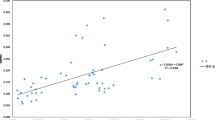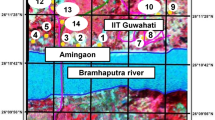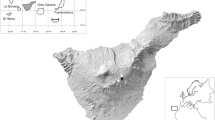Abstract
Decalepis arayalpathra, a critically endangered plant species, has a restricted and fragmented population in Southern Western Ghats, India. This study is a first attempt to evaluate genetic diversity and population structure in the nine wild populations of D. arayalpathra based on molecular pattern realized through the marker assays. Principal coordinate analysis (PCoA) and Nei’s unweighted pair-group method with arithmetic average (UPGMA)-based hierarchical clustering of both the marker assays suggest strong genetic clustering between the individuals corresponding to their geographical ranges. Mantel test also corroborates a close genetic proximity between genetic and geographic data (r = 0.389). Population genetic analysis revealed low levels of gene flow [inter-simple sequence repeat (ISSR) = 0.289 and random amplified polymorphic DNA (RAPD) = 0.847] between the populations, in line with high genetic differentiation (Gst = 0.531 with ISSR and 0.440 with RAPD), which was also supported by analysis of molecular variance (AMOVA), that 54 % (ISSR) and 64 % (RAPD) total variation resided within populations. Bayesian model-based STRUCTURE analysis detected three genetic clusters showing the high degree of admixture within population. Based on the findings, such as inbreeding depression and the loss of genetic diversity, suggestions for conservation strategies are provided to preserve the genetic resources of this endangered species.






Similar content being viewed by others
References
Hedrick, P. W., & Miller, P. S. (1992). Conservation genetics: techniques and fundamentals. Ecological Applications, 2, 30–46.
Hamrick, J. L., & Godt, M. J. W. (1995). Conservation genetics of endemic species. In J. C. Avise & J. L. Hamrick (Eds.), Conservation genetics (pp. 281–304). New York: Chapman and Hall Press.
Li, Y. Y., Guan, S. M., Yang, S. Z., Luo, Y., & Chen, X. Y. (2012). Genetic decline and inbreeding depression in an extremely rare tree. Conservation Genetics, 13, 343–347.
Choi, H. J., Kaneko, S., Yokogawa, M., Song, G. P., Kim, D. S., Kang, S. H., Suyama, Y., & Isagi, Y. (2013). Population and genetic status of a critically endangered species in Korea, Euchresta japonica (Leguminosae) and their implications for conservation. Journal of Plant Biology, 56, 251–257.
Reed, D. H., & Frankham, R. (2003). Correlation between fitness and genetic diversity. Conservation Biology, 17, 230–237.
Gong, W., Gu, L., & Zhang, D. (2010). Low genetic diversity and high genetic divergence caused by inbreeding and geographical isolation in the populations of endangered species Loropetalum subcordatum (Hamamelidaceae) endemic to China. Conservation Genetics, 11, 2281–2288.
Zhang, D. Q., Gao, L. M., & Yang, Y. P. (2010). Genetic diversity and structure of a traditional Chinese medicinal plant species, Fritillaria cirrhosa (Liliaceae) in southwest China and implications for its conservation. Biochemical Systematics and Ecology, 38, 236–242.
Zhao, X., Ma, Y., Sun, W., Wen, X., & Milne, R. (2012). High genetic diversity and low differentiation of Michelia coriacea (Magnoliaceae), a critically endangered endemic in Southeast Yunnan. China International Journal of Molecular Sciences, 13, 4396–4411.
Joseph, J., & Chandrasekaran, V. (1978). Janakia arayalpathra—a new genus and species of Periplocaceae from Kerala, South India. Journal of the Indian Botanical Society, 57, 308–312.
Venter, H. J. T., & Verhoeven, R. L. (1997). A tribal classification of the Periplocoideae (Asclepiadaceae). Taxon, 46, 705–720.
Prabakaran, V., Ravikumar, K., Vijayasankar. (2001). Janakia arayalpathra—the quest. Amruth, 5(5).
Pushpangadan, P., Rajasekaran, S., Ratheesh-Kumar, P. K., Jawahar, C. R., Radhakrishnan, K., Nair, C. P. R., Sarada-Amma, L., & Bhat, A. V. (1990). AMRITHAPALA (Janakia arayalpathra, Joseph and Chandrasekharan), a new drug from the Kani Tribe of Kerala. Ancient Science of Life, 9, 121.
Shine, V. J., Shyamal, S., Latha, P. G., & Rajasekharan, S. (2007). Gastric antisecretory and antiulcer activities of Decalepis arayalpathra. Pharmaceutical Biology, 45, 210–216.
Verma, R. S., Mishra, P., Kumar, A., Chauhan, A., Padalia, R. C., & Sundaresan, V. (2014). Chemical composition of root aroma of Decalepis arayalpathra (J. Joseph and V. Chandras.) Venter, an endemic and endangered ethnomedicinal plant from Western Ghats. India Natural Product Research, 28, 1202–1205.
Sudha, C. G., & Seeni, S. (2001). Establishment and analysis of fast-growing normal root culture of Decalepis arayalpathra, a rare endemic medicinal plant. Current Science, 81, 371–374.
Molur, S., & Walker (1997). Report on conservation assessment and management plan (CAMP) workshop for selected species of medicinal plants of southern India, Bangalore, 16–18, (p. 108).
Ravikumar, K., & Ved, D. K. (2000). Illustrated field guide to 100 red listed medicinal plants of conservation concern in southern India. Bangalore: FRLHT.
Anonymous. (2011) Tamil Nadu State Biodiversity Notification, Ministry of Environment and Forests, New Delhi, India. REGD. No. D.L-33004/99.
Sarkar, M. K. (2010). Management strategies for endemic and threatened medicinal plants in India—a geoinformatic approach: with special reference to Kalakad Mundanthurai Tiger Reserve, Southern Western Ghats of Tamil Nadu. Department of Environment, Government of Tamil Nadu.
Premalatha, K., Gokul, S., Kumar, A., Mishra, P., Mishra, P., Ravikumar, K., & Kalra, A. (2014). Molecular profiling of fungal assemblages in the healthy and infected roots of Decalepis arayalpathra (J. Joseph and V. Chandras.) Venter, an endemic and endangered ethnomedicinal plant from Western Ghats, India. Annals of Microbiology. doi:10.1007/s13213-014-0919-7.
Schaal, B. A., Leverich, W. J., & Rogstad, S. H. (1991). A comparison of methods for assessing genetic variation in plant conservation biology. In D. A. Falk & K. E. Holsinger (Eds.), Genetics and conservation of rare plants (pp. 123–134). New York: Oxford University Press.
Vergeer, P., Ouborg, N. J., & Hendry, A. P. (2008). Genetic considerations of introduction efforts. In S. P. Carroll & C. W. Fox (Eds.), Conservation biology—evolution in action (pp. 116–129). Oxford: Oxford University Press.
Yao, X., Deng, J., & Huang, H. (2012). Genetic diversity in Eucommia ulmoides (Eucommiaceae), an endangered traditional Chinese medicinal plant. Conservation Genetics, 13, 1499–1507.
Kumar, A., Mishra, P., Singh, S. C., & Sundaresan, V. (2014). Efficiency of ISSR and RAPD markers in genetic divergence analysis and conservation management of Justicia adhatoda L., a medicinal plant. Plant Systematics and Evolution, 300, 1409–1420.
Williams, J. G. K., Kubelik, A. R., Livak, K. J., Rafalski, J. A., & Tingey, S. V. (1990). DNA polymorphisms amplified by arbitrary primers are useful as genetic markers. Nucleic Acids Research, 18, 6531–6535.
Zietkiewicz, E., Rafalski, A., & Labuda, D. (1994). Genome fingerprinting by simple sequence repeat (SSR)-anchored polymerase chain reaction amplification. Genomics, 20, 176–183.
Yang, W., de-Oliveira, A. C., Godwin, I., Schertz, K., & Bennetzen, J. L. (1996). Comparison of DNA marker technologies in characterizing plant genome diversity: variability in Chinese sorghums. Crop Science, 36, 1669–1676.
Bornet, B., & Branchard, M. (2001). Non-anchored inter-simple sequence repeat (ISSR) markers: reproducible and specific tools for genome fingerprinting. Plant Molecular Biology Reporter, 19, 209–215.
Khanuja, S. P. S., Shasany, A. K., Darokar, M. P., & Kumar, S. (1999). Rapid isolation of DNA from dry and fresh samples of plants producing large amounts of secondary metabolites and essential oils. Plant Molecular Biology Reporter, 17, 1–7.
Leonard, D. S. (2009). A visual approach to SPSS for windows: a guide to SPSS 17.0, Needham Heights. MA: Allyn and Bacosn Inc.
Van-De-Peer, Y., & Wachter, R. (1994). TREECON for Windows: a software package for the construction and drawing of evolutionary trees for the Microsoft Windows environment. Computer Applications in the Biosciences, 10, 569–570.
Nei, M. (1973). Analysis of gene diversity in subdivided populations. P.N.A.S., 70, 3321–3323.
Felsenstein, J. (1985). Confidence limits on phylogenies: an approach using the bootstrap. Evolution, 39, 783–791.
Peakall, R., & Smouse, P. E. (2006). GenAlEx V 6: genetic analysis in Excel. Population genetic software for teaching and research. Molecular Ecology Notes, 6, 288–295.
Roldan-Ruiz, I., Dendauw, J., Vanbockstaele, E., Depicker, A., & De-Loose, M. (2000). AFLP markers reveal high polymorphic rates in ryegrasses (Lolium spp.). Mol. Breed, 6, 125–134.
Varshney, R. K., Chabane, K., Hendre, P. S., Aggarwal, R. K., & Graner, A. (2007). Comparative assessment of EST-SSR, EST-SNP and AFLP markers for evaluation of genetic diversity and conservation of genetic resources using wild, cultivated and elite barleys. Plant Science, 173, 638–649.
Prevost, A., & Wilkinson, M. J. (1999). A new system of comparing PCR primers applied to ISSR fingerprinting of potato cultivars. Theoretical and Applied Genetics, 98, 107–112.
Yeh, F., Yang, R., & Boyle, T. (1999). Microsoft window-based freeware for population genetic analysis (POPGENE Ver. 1.32). Canada: University of Alberta.
Lewinton, R. C. (1972). The apportionment of human diversity. Evolutionary Biology, 6, 381–398.
Nei, M. (1987). Molecular evolutionary genetics. New York: Columbia University Press.
Pritchard, J. K., Stephens, M., & Donnelly, P. (2000). Inference of population structure from multilocus genotype data. Genetics, 155, 945–959.
Falush, D., Stephens, M., & Pritchard, J. K. (2003). Inference of population structure using multilocus genotype data: linked loci and correlated allele frequencies. Genetics, 164, 1567–1587.
Earl, D. A., & von-Holdt, B. M. (2012). STRUCTURE HARVESTER: a website and program for visualizing STRUCTURE output and implementing the Evanno method. Conservation Genetics Resources, 4, 359–361.
Evanno, G., Regnaut, S., & Goudet, J. (2005). Detecting the number of clusters of individuals using the software STRUCTURE: a simulation study. Molecular Ecology, 14, 2611–2620.
Mantel, N. (1967). The detection of disease clustering and a generalized regression approach. Cancer Research, 27, 209–220.
Ersts, P. J. Geographic Distance Matrix Generator (version 1.2.3). American Museum of Natural History, Centre for Biodiversity and Conservation. Available from: http://biodiversityinformatics.amnh.org/open_source/gdmg. Accessed August 20, 2014.
Frankel, O. H., Brown, A. H. D., & Burdon, J. J. (1995). The conservation of plant biodiversity. Cambridge: Cambridge University.
Spielman, D., Brook, B. W., & Frankham, R. (2004). Most species are not driven to extinction before genetic factors impact them. P.N.A.S., 10, 15261–15264.
Nybom, H., & Bartish, I. V. (2000). Effects of life history traits and sampling strategies on genetic diversity estimates obtained with RAPD markers in plants. P.P.E.E.S., 3, 93–114.
Ellstrand, N. C., & Elam, D. R. (1993). Population genetic consequences of small population size: implications for plant conservation. Annual Review of Ecology, Evolution, and Systematics, 24, 217–242.
Hamrick, J. T., & Godt, M. J. (1996). Effects of life history traits on genetic diversity in plant species. Philosophical Transactions of the Royal Society London B., 351, 1291–1298.
Nei, M. (1978). Estimation of average heterozygosity and genetic distance from a small number of individuals. Genetics, 89, 583–590.
Milligan, B. G., Mack, J. L., & Strand, A. E. (1994). Conservation genetics: beyond the maintenance of marker diversity. Molecular Ecology, 3, 423–435.
Acknowledgments
The financial support from the Council of Scientific and Industrial Research (CSIR), New Delhi, India, through the XIIth FYP projects Biopros-PR (BSC-0106) and ChemBio (BSC-0203), is gratefully acknowledged. The authors are thankful to the Tamil Nadu Biodiversity Board and Principal Chief Conservator of Forests & Chief Wildlife Warden, Tamil Nadu Forest Department, for granting the permission to take up this study.
Conflict of Interest
The authors declare that they have no conflict of interest.
Author information
Authors and Affiliations
Corresponding author
Rights and permissions
About this article
Cite this article
Mishra, P., Kumar, L.D., Kumar, A. et al. Population Dynamics and Conservation Implications of Decalepis arayalpathra (J. Joseph and V. Chandras.) Venter., a Steno Endemic Species of Western Ghats, India. Appl Biochem Biotechnol 176, 1413–1430 (2015). https://doi.org/10.1007/s12010-015-1654-7
Received:
Accepted:
Published:
Issue Date:
DOI: https://doi.org/10.1007/s12010-015-1654-7




